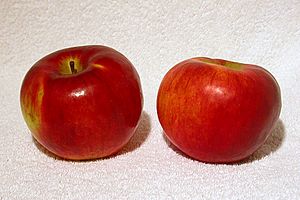Cortland (apple) facts for kids
Quick facts for kids 'Cortland' |
|
|---|---|
 |
|
| Hybrid parentage | 'McIntosh' × 'Ben Davis' |
| Cultivar | 'Cortland' |
| Origin | Geneva, New York, United States, 1898 |
The Cortland is a special type of apple called a cultivar. It was created in 1898 at the New York State Agricultural Experiment Station in Geneva, New York, United States. This apple was named after a nearby place, Cortland County, New York. It is one of the top fifteen most popular apples in the United States and Canada. Cortland apples have about 12.5% sugar, 8 grams of acid per liter, and 6 milligrams of vitamin C per 100 grams.
Contents
How the Cortland Apple Was Created
After people discovered how great the McIntosh apple was, plant breeders wanted to make it even better. They started mixing it with other apple types. One of the first new apples they created was the 'Cortland'.
What Makes Cortland Special?
The Cortland apple tastes sweeter than a McIntosh. It has a beautiful red color, often with a pale yellow or green background. You might also see short, dark red stripes and small gray-green dots on its skin. Inside, the flesh of a Cortland apple is white. A great thing about Cortland apples is that their white flesh does not turn brown quickly after you cut them. This makes them perfect for salads and fruit platters.
The first Cortland apple was bred by an American plant expert named S.A Beach.
Different Kinds of Cortland Apples
The original Cortland apple was introduced in 1915. It usually had about 20–30% red color. Over time, some Cortland apple trees naturally changed a little. These changes are called "sports." A "sport" is like a natural mutation in a plant that creates a new, slightly different version.
What Are Patented Sports?
Some of these "sports" were even redder or had other improved features. When a new "sport" is found and grown, it can sometimes be "patented." This means the person who found it gets special rights to grow and sell that specific new version. For example, some Cortland sports were developed to be much redder, sometimes up to 90% red. These new versions helped make the Cortland apple even more popular.
Apples Related to Cortland
The Cortland apple has also been used to create new types of apples. One apple that came from the Cortland is:
- Birgit Bonnier
See also
 In Spanish: Cortland (manzana) para niños
In Spanish: Cortland (manzana) para niños

